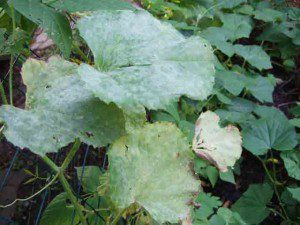Yesterday Bob Guillow from the Garden Manuals website shared a list of common sense disease preventive practices for the backyard vegetable garden. Today Bob returns to identify a few of the major diseases that you may encounter, and also offers suggestions to keep them under control…
There are both chemical and non-chemical controls for solving disease problems. It should be noted that fungicides should be used only as a last resort, when all other control tactics have been exhausted. Many of these products are highly toxic, rating a signal word of “danger” or “warning.”
Common Diseases that are Present in Backyard Gardens
 The following are some of the most common diseases you’ll be faced with along with some information on the plants they attack and some remedies – both chemical and non-chemical:
The following are some of the most common diseases you’ll be faced with along with some information on the plants they attack and some remedies – both chemical and non-chemical:
Bacterial Wilt – A common disease of cucumbers, bacterial wilt also afflicts muskmelons, squash and pumpkins. Most troublesome east of the Rockies, it is prevalent during moist weather. Cucumber beetles feeding on foliage usually spread it. Symptoms include rapid wilting of plants and death of young seedlings.
Check for the disease by cutting a stem near the base and squeezing it; if present, bacteria will ooze out in a sticky mass. Try using floating covers to keep beetles off plants or spray with pyrethrin.
Gummosis and Cankers – These are both terms used to describe various bacterial or fungal diseases that cause oozing, sunken lesions on trunks or limbs of afflicted trees and shrubs. The problem is most commonly seen on fruit trees, and often gets its start when the disease organism enters through a wound or borer entry hole.
To prevent this problem, avoid over watering and take care not to injure plants. Protect young trees from sunscald by wrapping the trunks loosely in burlap. If the plant is generally healthy, it will usually seal off the cankers. If the canker appears on a small limb, prune it out well below the canker; disinfect tools between cuts.
Powdery Mildew – This fungal disease attacks a wide variety of plants, including all sorts of beans, clematis, dahlia, grape, rose, strawberry, tomato, and zinnia, and trees such as apple, maple, oak, peach, and sycamore. It is favored by moist air, shade, and poor air circulation, but needs dry leaves to become established.
The first symptoms are small gray or white circles on leaves, stems and flowers; then entire leaves or blooms become powdery white and distorted. Some plants remain vigorous despite the infection, but others decline or fail to set fruit. Some flowering plants can become so disfigured that they must be removed from the garden.
To prevent powdery mildew, plant resistant varieties and routinely spray plants with jets of water to wash off fungus spores. Increase sunlight to plants by avoiding overcrowding. In the fall, discard infected flowers, fruits, and plants.
Sulfur may help; on roses and other flowering plants, try a baking soda and summer oil spray. Some gardeners report success with the anti-transpirant sprays sold to protect tender plants from cold. Such sprays keep the surface temperature of treated leaves somewhat higher than that of the surrounding air; apparently, they also prevent mildew spores from attaching to foliage.
Maintaining a Happy, Healthy, Disease-Free Vegetable Garden
Hopefully the above information will help you to maintain a beautiful and healthy garden. When disease is handled quickly and properly, you can keep your garden at its best with just regular care. A garden can add joy and therapy to your life, and a healthy garden leads to a happy gardener.
Bob Guillow has been a content writer for over 10 years. His expertise ranges from gardening to IT. His website, http://gardenmanuals.com is the culmination of six years of gardening experience.



3 Responses
My red peppers never make it to maturity. They are black at ends and are rotting. I planted them in mushroom dirt . I sprayed them with something to prevent the buds from rotting. The plants themselves are enormous and very healthy. What is causing the peppers to rot? I live in Chattanooga TN. Is it a moisture problem or is the dirt too rich. Next season I will put lime in the soil? Chris
Hi Chris, I don’t think that it is a problem with your soil being too rich, more likely it is a moisture related problem. Since the plants look healthy I would just keep them growing and hope for additional fruit set that will reach maturity.